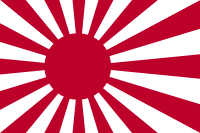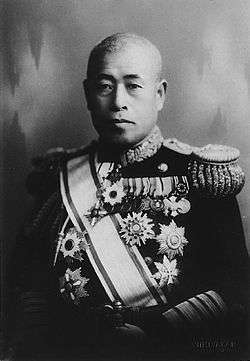Combined Fleet
- For the "Carrier Striking Task Force", see Kido Butai.
| 聯合艦隊 Rengo Kantai Combined Fleet (Imperial Japanese Navy) | |
|---|---|
 | |
| Active | 1894–1945 |
| Country | Empire of Japan |
| Allegiance |
|
| Type | Sea-going component of Imperial Japanese Navy |
| Engagements |
First Sino-Japanese War Russo-Japanese War World War I Second Sino-Japanese War World War II |
| Commanders | |
| Notable commanders |
Isoroku Yamamoto Tōgō Heihachirō Hiroyasu Fushimi and many others |
| Insignia | |
| Identification symbol |
 Imperial Seal of Japan and Seal of the Imperial Japanese Navy |
Combined Fleet (聯合艦隊 Rengō Kantai) was the main ocean-going component of the Imperial Japanese Navy. Until 1933, Combined Fleet was not a permanent organization, but a temporary force formed for the duration of a conflict or major naval maneuvers from various units normally under separate commands in peacetime.
History
Sino-Japanese War (1894–95)
Combined Fleet was formally created for the first time on 18 July 1894 by the merger of the Standing Fleet and the Western Fleet. The Standing Fleet (also known as the Readiness Fleet) contained the navy's most modern and combat-capable warships. The Western Fleet was a reserve force consisting primarily of obsolete ships deemed unsuitable for front-line combat operations, but still suitable for commerce protection and coastal defense. Vice-admiral Itō Sukeyuki was appointed the first Commander-in-Chief of Combined Fleet[1] for the duration of the first Sino-Japanese War against China.
Russo-Japanese War (1904–05)
Combined Fleet was re-formed during the Russo-Japanese War of 1904–05 to provide a unified overall command for the three separate fleets in the Imperial Japanese Navy. The IJN 1st Fleet was the main battleship force, which formed the backbone of the navy and was intended to be used in a traditional line-of-battle showdown with an equivalent enemy battleship fleet (kantai kessen). The IJN 2nd Fleet was a fast, mobile strike force with armored cruisers and protected cruisers. The IJN 3rd Fleet was primarily a reserve fleet of obsolete vessels considered too weak for front-line combat service, but which could still be used in the operation to blockade Port Arthur. Admiral Tōgō Heihachirō was commander-in-chief of Combined Fleet during the Russo-Japanese War.
Interwar years
Combined Fleet was not maintained as a permanent organization, but was temporarily created when necessary during fleet maneuvers or when called for by extraordinary circumstances. Thus, during the period from 1905–1924, Combined Fleet was created only sporadically as the occasion or circumstances dictated, and disbanded immediately afterwards.
In 1924, the Imperial Japanese Navy declared in an edict on fleet organization that "for the time being" Combined Fleet would be a standing organization consisting of the IJN 1st Fleet and IJN 2nd Fleet. As this was not intended to be "permanent" and since the commander of IJN 1st Fleet concurrently directed Combined Fleet, Combined Fleet was not given a Headquarters staff of its own.
From 1933, with the Manchurian Incident and the increasing tension with China, a permanent HQ staff for Combined Fleet was established. By the late 1930s, it included most of Japan's warships—only the base units, the Special Naval Landing Forces, and the China Area Fleet lay outside Combined Fleet.
World War II

Combined Fleet came under direct command of the Imperial General Headquarters in 1937. With the start of the Pacific War with the attack on Pearl Harbor carried out by Combined Fleet's Kido Butai, Combined Fleet became almost synonymous with the Imperial Japanese Navy. It comprised the battleships, aircraft carriers, aircraft, and the components that made up the main fighting strength of the IJN. It was first mobilized on the whole for the Battle of Midway. After the devastating carrier losses at Midway and in the Solomon Islands campaign, the navy re-organized into a number of "Area Fleets" for local operational control of various geographic zones. Combined Fleet then evolved into more of an administrative organization.
As the war situation deteriorated for the Japanese and the territories controlled by the "Area Fleets" fell one after another to the United States Navy, the Imperial General Headquarters and the Imperial Japanese Navy General Staff acted to force the American fleet into a "decisive battle" in the Philippines per the kantai kessen philosophy. In the resultant Battle of the Philippine Sea and the Battle of Leyte Gulf the Japanese fleet was severely depleted. The remnants of Combined Fleet fled to Okinawa, but further operations were hindered by lack of fuel and air cover. By the time of the final suicide mission of the battleship Yamato in Operation Ten-Go, Combined Fleet had ceased to exist as an effective combat force.
Commanders of the IJN Combined Fleet
Commander in chief
| Rank | Name | From | To | |
|---|---|---|---|---|
| 1 | Vice Admiral | Itō Sukeyuki | 18 July 1894 | 11 May 1895 |
| 2 | Vice Admiral | Arichi Shinanojo | 11 May 1895 | 16 November 1895 |
| 3 | Vice Admiral | Tōgō Heihachirō | 28 December 1903 | 20 December 1905 |
| 4 | Vice Admiral | Ijuin Goro | 8 October 1908 | 20 November 1908 |
| 5 | Vice Admiral | Motaro Yoshimatsu | 1 November 1915 | 13 December 1915 |
| 6 | Vice Admiral | Motaro Yoshimatsu | 1 September 1916 | 14 October 1916 |
| 7 | Admiral | Motaro Yoshimatsu | 1 October 1917 | 22 October 1917 |
| 8 | Admiral | Yamashita Gentaro | 1 September 1918 | 15 October 1918 |
| 9 | Admiral | Yamashita Gentaro | 1 June 1919 | 28 October 1919 |
| 10 | Admiral | Yamaya Tanin | 1 May 1920 | 24 August 1920 |
| 11 | Admiral | Tochinai Sojiro | 24 August 1920 | 31 October 1920 |
| 12 | Admiral | Tochinai Sojiro | 1 May 1921 | 31 October 1921 |
| 13 | Vice Admiral | Takeshita Isamu | 1 December 1922 | 27 January 1924 |
| 14 | Admiral | Suzuki Kantaro | 27 January 1924 | 1 December 1924 |
| 15 | Admiral | Okada Keisuke | 1 December 1924 | 10 December 1926 |
| 16 | Vice Admiral | Hiroharu Kato | 10 December 1926 | 10 December 1928 |
| 17 | Admiral | Naomi Taniguchi | 10 December 1928 | 11 November 1929 |
| 18 | Vice Admiral | Eisuke Yamamoto | 11 November 1929 | 1 December 1931 |
| 19 | Vice Admiral | Seizō Kobayashi | 1 December 1931 | 15 November 1933 |
| 20 | Vice Admiral | Nobumasa Suetsugu | 15 November 1933 | 15 November 1934 |
| 21 | Vice Admiral | Sankichi Takahashi | 15 November 1934 | 1 December 1936 |
| 22 | Vice Admiral | Mitsumasa Yonai | 1 December 1936 | 2 February 1937 |
| 23 | Admiral | Osami Nagano | 2 February 1937 | 1 December 1937 |
| 24 | Vice Admiral | Zengo Yoshida | 1 December 1937 | 30 August 1939 |
| 25 | Admiral | Isoroku Yamamoto | 30 August 1939 | 18 April 1943 |
| 26 | Admiral | Mineichi Koga | 21 May 1943 | 31 March 1944 |
| 27 | Admiral | Soemu Toyoda | 3 May 1944 | 29 May 1945 |
| 28 | Vice Admiral | Jisaburo Ozawa | 29 May 1945 | 10 October 1945 |
Chief of staff
| Rank | Name | From | To | |
|---|---|---|---|---|
| 1 | Captain | Samejima Kazunori | 19 July 1894 | 17 December 1894 |
| 2 | Captain | Dewa Shigeto | 17 December 1894 | 25 July 1895 |
| 3 | Captain | Kamimura Hikonojo | 25 July 1895 | 16 November 1895 |
| 4 | Captain | Shimamura Hayao | 28 December 1903 | 12 January 1905 |
| 5 | Rear Admiral | Kato Tomosaburo | 12 January 1905 | 20 December 1905 |
| 6 | Rear Admiral | Fujii Koichi | 20 December 1905 | 22 November 1906 |
| 7 | Captain | Yamashita Gentaro | 22 November 1906 | 10 December 1908 |
| 8 | Captain | Takarabe Takeshi | 10 December 1908 | 1 December 1909 |
| 9 | Rear Admiral | Nomaguchi Kaneo | 1 December 1909 | 11 March 1911 |
| 10 | Captain | Akiyama Saneyuki | 11 March 1911 | 24 May 1912 |
| 11 | Captain | Isamu Takeshita | 1 December 1912 | 24 May 1913 |
| Vacant | 23 May 1913 | 1 December 1913 | ||
| 12 | Rear Admiral | Satō Tetsutarō | 1 December 1913 | 17 April 1914 |
| 13 | Captain | Kazuyoshi Yamaji | 17 April 1914 | 1 December 1914 |
| 14 | Rear Admiral | Shibakichi Yamanaka | 1 December 1914 | 13 December 1915 |
| 15 | Rear Admiral | Saburo Horiuchi | 13 December 1915 | 1 December 1917 |
| 16 | Rear Admiral | Hanroku Saito | 1 December 1917 | 1 December 1918 |
| 17 | Rear Admiral | Kajishiro Funakoshi | 1 December 1918 | 1 December 1919 |
| 18 | Rear Admiral | Hansaku Yoshioka | 1 December 1919 | 1 December 1921 |
| 19 | Rear Admiral | Kumazo Shirane | 1 December 1921 | 1 December 1923 |
| 20 | Rear Admiral | Bekinari Kabayama | 1 December 1923 | 10 November 1924 |
| 21 | Captain | Kanjiro Hara | 10 November 1924 | 1 December 1925 |
| 22 | Rear Admiral | Naotaro Ominato | 1 December 1925 | 1 November 1926 |
| 23 | Rear Admiral | Sankichi Takahashi | 1 November 1926 | 1 December 1927 |
| 24 | Rear Admiral | Eijiro Hamano | 1 December 1927 | 10 December 1928 |
| 25 | Rear Admiral | Ken Terajima | 10 December 1928 | 30 October 1929 |
| 26 | Rear Admiral | Koichi Shiozawa | 30 October 1929 | 1 December 1930 |
| 27 | Rear Admiral | Shigetarō Shimada | 1 December 1930 | 1 December 1931 |
| 28 | Rear Admiral | Zengo Yoshida | 1 December 1931 | 15 September 1933 |
| 29 | Rear Admiral | Soemu Toyoda | 15 September 1933 | 15 March 1935 |
| 30 | Rear Admiral | Nobutake Kondō | 15 March 1935 | 15 November 1935 |
| 31 | Rear Admiral | Naokuni Nomura | 15 November 1935 | 16 November 1936 |
| 32 | Rear Admiral | Yasutaro Iwashita | 16 November 1936 | 18 February 1937 |
| 33 | Rear Admiral | Jisaburo Ozawa | 18 February 1937 | 15 November 1937 |
| 34 | Rear Admiral | Ibo Takahashi | 15 November 1937 | 5 November 1939 |
| 35 | Captain | Shigeru Fukudome | 5 November 1939 | 10 April 1941 |
| 36 | Rear Admiral | Seiichi Ito | 10 April 1941 | 11 August 1941 |
| 37 | Rear Admiral | Matome Ugaki | 11 August 1941 | 22 May 1943 |
| 38 | Vice Admiral | Shigeru Fukudome | 22 May 1943 | 6 April 1944 |
| 39 | Rear Admiral | Ryunosuke Kusaka | 6 April 1944 | 24 June 1945 |
| 40 | Rear Admiral | Shikazo Yano | 24 June 1945 | 25 September 1945 |
References
Notes
Books
External links
- Nishida, Hiroshi. "Imperial Japanese Navy". Retrieved 2007-08-25.
- Wendel, Marcus. "Axis Database". Retrieved 2007-08-25.
- World War II Armed Forces – Orders of Battle and Organizations
- Nihon Kaigun